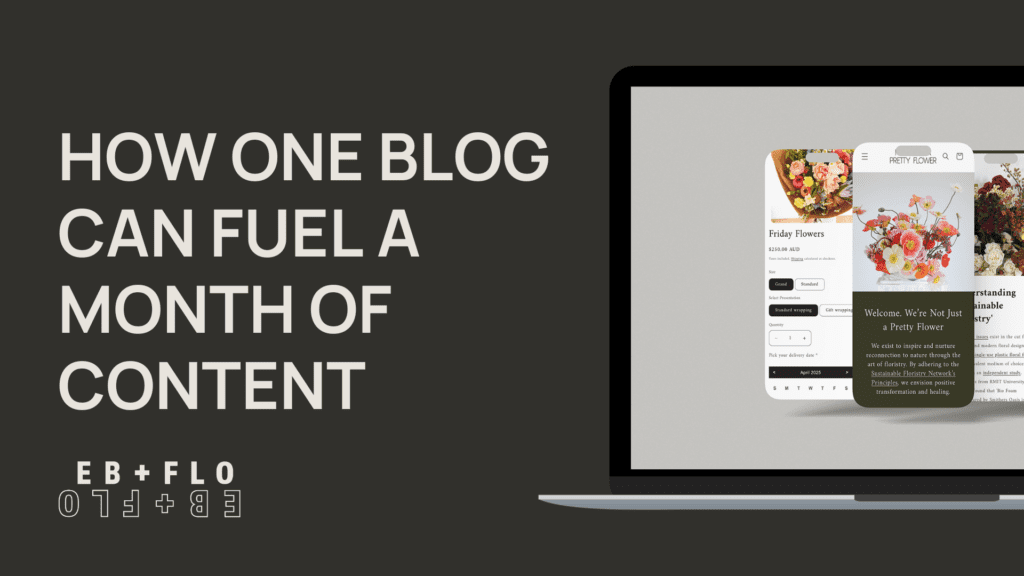Ever feel like content creation is a never-ending treadmill? Creating content demands consistent output across multiple platforms. For many businesses, this presents a significant challenge: producing enough quality content to maintain visibility without exhausting resources. Content repurposing offers an effective solution to this common problem.
This strategic approach allows you to maximise the value of your original content by adapting it for different platforms and formats. Rather than creating everything from scratch, you can extend the reach and lifespan of your best ideas.
The “Create Once, Distribute Everywhere” Strategy
Content repurposing follows a straightforward principle: create high-quality cornerstone content, then adapt it to suit various platforms and audience preferences. This approach is both resource-efficient and effective for maintaining a consistent brand message.
Here’s how to transform one monthly blog post into content for your entire digital ecosystem:
1. Start With a Comprehensive Blog Post
Your blog serves as the foundation of your content strategy. Create a thorough, valuable post that addresses topics relevant to your audience. A well-structured blog post naturally segments into smaller content pieces, making the repurposing process more efficient.
2. Instagram
Instagram users prefer visually engaging content that delivers value quickly. Adapt your written content to match Instagram’s visual-first environment. This typically requires condensing information into concise, impactful statements that complement your visuals.
3. LinkedIn
LinkedIn users seek content with professional applications and are receptive to more detailed explanations when they provide value. Emphasise the strategic elements of your content. Focus on the “why” and “how” rather than just the “what”, as LinkedIn users value applicable insights.
4. Email Newsletters
Email subscribers represent your most engaged audience segment. They’ve explicitly opted to receive your content. From your blog, develop a condensed version with a link to the complete post. It’s also important to provide email subscribers with additional value for their engagement. Consider offering exclusive insights or resources not available on public platforms.
Essential Tools for Efficient Content Repurposing
Effective content repurposing requires the right tools to streamline workflows and maintain quality. Here are recommended solutions for each stage of the process:
Content Planning and Management
When planning your content strategy, tools like Trello or Asana help structure your content repurposing workflow effectively. Notion allows you to create filterable content databases organised by platform, topic, or status.
Visual Content Creation
For transforming your blog content into engaging visuals, Canva stands as the essential tool in content repurposing. This versatile platform offers thousands of customisable templates specifically designed for each social media channel’s unique dimensions and formats. With Canva, you can quickly create Instagram carousel posts, LinkedIn headers, and email graphics – all maintaining consistent branding.
Scheduling and Automation
When it comes to scheduling your repurposed content, Later stands out as the premier solution for social media management. Originally designed for Instagram, Later has evolved into a comprehensive platform that now supports scheduling across Instagram, TikTok, Pinterest, Facebook, LinkedIn, and X (formerly Twitter).
Analytics
Measure your success with tools like Google Analytics to track traffic sources from repurposed content. Google Analytics’ conversion tracking shows which repurposed content pieces not only drive traffic but actually convert visitors into leads or customers. This data-driven approach ensures your repurposing strategy continuously improves based on real performance metrics.
Common Repurposing Challenges to Avoid
When implementing a content repurposing strategy, be mindful of these potential pitfalls:
- Direct Replication: Each platform has unique requirements and audience expectations. Customise content accordingly rather than using identical messaging.
- Content Overextension: Not every blog post supports extensive repurposing. Focus on quality over quantity when adapting content.
- Overlooking Analytics: Monitor performance metrics to identify which repurposed formats generate the strongest engagement on each platform.
- Underutilising Platform Features: Incorporate native features like Stories, Reels, and Carousels to maximise engagement potential.
Long-Term Benefits of Content Repurposing
Content repurposing isn’t just a short-term tactic – it’s a fundamental shift in how you approach content creation. When implemented consistently, this strategy delivers compound benefits that extend far beyond immediate time savings.
First, repurposing creates a more cohesive brand narrative. When your audience encounters similar messaging across different platforms, it reinforces your key ideas and strengthens brand recognition. This repetition helps your core message stick.
Second, it allows you to test which formats resonate best with different audience segments. You might discover that your blog readers prefer comprehensive guides, while your Instagram followers engage more with quick visual tutorials. These insights help refine your overall content strategy.
Perhaps most importantly, content repurposing gradually builds a valuable content ecosystem where pieces complement and reinforce each other. Your LinkedIn article drives traffic to your blog, which promotes your email newsletter, which highlights your Instagram tutorials – creating a seamless journey for your audience.
Looking to build a content strategy that does more with less? Let’s talk about how we can help you build an efficient repurposing system tailored to your business.




